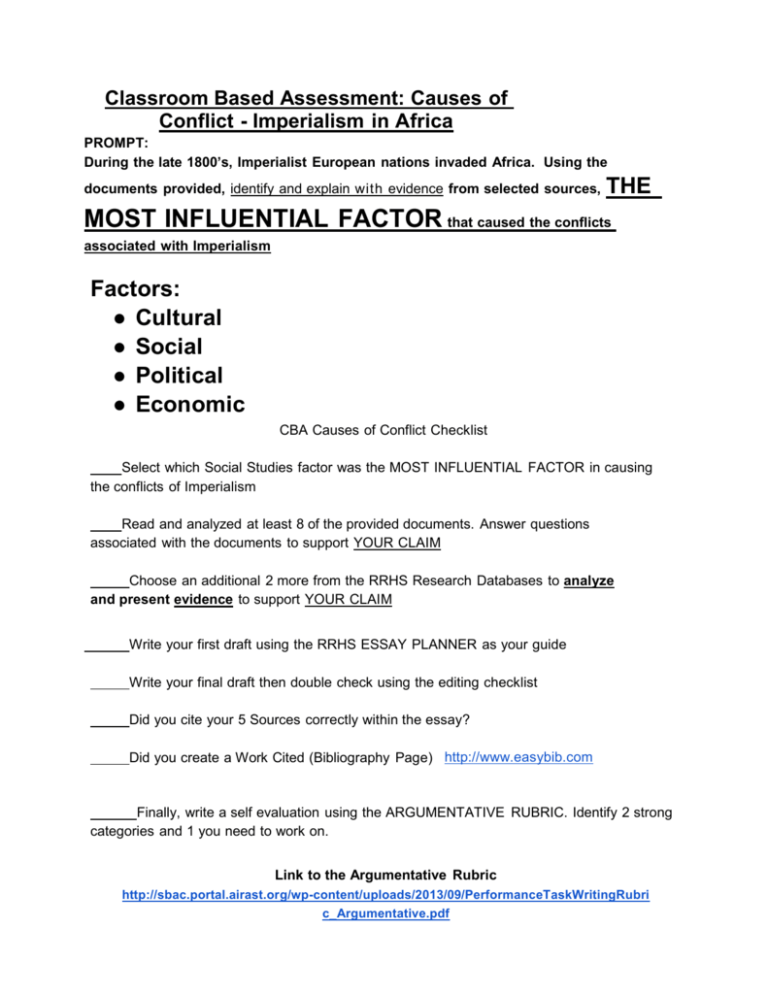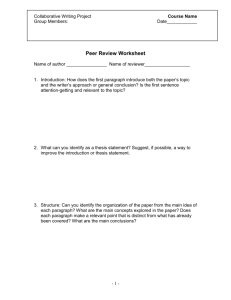CBA 1st semester
advertisement

Classroom Based Assessment: Causes of Conflict - Imperialism in Africa PROMPT: During the late 1800’s, Imperialist European nations invaded Africa. Using the documents provided, identify and explain with evidence from selected sources, THE MOST INFLUENTIAL FACTOR that caused the conflicts associated with Imperialism Factors: ● Cultural ● Social ● Political ● Economic CBA Causes of Conflict Checklist Select which Social Studies factor was the MOST INFLUENTIAL FACTOR in causing the conflicts of Imperialism Read and analyzed at least 8 of the provided documents. Answer questions associated with the documents to support YOUR CLAIM Choose an additional 2 more from the RRHS Research Databases to analyze and present evidence to support YOUR CLAIM Write your first draft using the RRHS ESSAY PLANNER as your guide Write your final draft then double check using the editing checklist Did you cite your 5 Sources correctly within the essay? Did you create a Work Cited (Bibliography Page) http://www.easybib.com Finally, write a self evaluation using the ARGUMENTATIVE RUBRIC. Identify 2 strong categories and 1 you need to work on. Link to the Argumentative Rubric http://sbac.portal.airast.org/wp-content/uploads/2013/09/PerformanceTaskWritingRubri c_Argumentative.pdf Source #1 -Overview of Imperialism in Africa Candice Goucher, Charles LeGuin, Linda Walton, In the Balance: Themes in Global History (Boston: McGraw-Hill, 1998), selections from chapter 17, “The Tentacles of Empire: The New Imperialism and New Nationalism in Asia, Africa, and the Americas.” Abstract: This essay explores the later stages of imperialism from Africa to Asia and the Americas. The New Imperialism in Africa Expansion fueled by capitalist industrialism and nationalism brought previously unsubjugated lands under European control during the nineteenth century. At its height the British Empire alone consisted of over a quarter of the world’s land mass and people. By 1914 Europe together with its colonial possessions occupied more than 80 percent of the globe. The conquest of Africa provided perhaps the clearest example of what is sometimes called the “new imperialism,” an era roughly beginning in Africa in the 1880s and continuing into the twentieth century. The Berlin Conference At the Berlin Conference in 1884–1885, European powers and the United States met to protect their “spheres of influence” (areas of special economic and political interests) and to establish mechanisms for making new territorial claims. The scramble for African territory was underway. An earlier catalyst for the scramble for territories came from King Leopold II of Belgium (r. 1865– 1909). Motivated by greed and ambition to expand the wealth and territory of his small European kingdom, Leopold undertook what he called a crusade to acquire the Congo Free State (later, Zaire). The relatively swift imposition of European colonial rule in Africa following the Berlin Conference also needs to be understood against the backdrop of several centuries of the Atlantic slave trade, the rise of an African merchant class, and the penetration of merchant capital prior to 1900. These forces undermined the earlier systems of authority on the continent and prevented African societies from dealing with the European presence in any unified way. MAPS Source #2 ● Animated Map: The Scramble for Africa Map Analysis Worksheet Question 1. Creator 2. Date 3. Title 4. Map Format (Circle One) Economic or resource Climate Topographical Physical Street Map/Road Map 5. What features are shown in the map key? 6. Why was this map made? 7. Explain why this map is important to the history of Imperialism in Africa. Explain what it is showing. Source # 3 ● Matthew White map Map Analysis Worksheet Questions 1. Creator 2. Date 3. Title 4. Map Format (Circle One) Economic or resource Climate Topographical Physical Street Map/Road Map 5. What features are shown in the map key? 6. Why was this map made? 7. Explain why this map is important to the history of Imperialism in Africa. Explain what it is showing. Articles/Reading: Sources # 4, 5, 6 (pick 2 of the 3) ● ● ● Moshweshewe: Letter to Sir George Grey (1858 - South Africa Kaiser Wilhelm II - Place in the Sun Speech (1901) (focus on paragraph one) Rudyard Kipling: White Man’s… Document Analysis; Author: Title: Year: Publisher / Source: What type of evidence does the author use? - a story - data, facts, statistics - expert testimony - eye witness - a research study - other What is the evidence? ● Directly quote OR paraphrase the source. ● Make sure you reference the paragraph number. Paragraph # Paragraph # Paragraph # Why is the information or evidence important - Purpose - Appeal - Rebuttal Document Analysis; Author: Title: Year: Publisher / Source: What type of evidence does the author use? - a story - data, facts, statistics - expert testimony - eye witness - a research study - other What is the evidence? ● Directly quote OR paraphrase the source. ● Make sure you reference the paragraph number. Paragraph # Paragraph # Paragraph # Why is the information or evidence important - Purpose - Appeal - Rebuttal Political Cartoons: Sources #7, 8 (choose 1) ● The Rhodes Collosus ● In The Rubber Coils - Punch Magazine Use National Archives and records analysis sheet http://www.archives.gov/education/lessons/worksheets/cartoon_analysis_worksheet.pdf Video: Sources # 9, 10 ● A Brief History of European Colonization in Africa - YouTube ● Congo - The Brutal History - YouTube Motion Picture Analysis Worksheet -National Archives http://www.archives.gov/education/lessons/worksheets/motion_picture_analysis_worksheet.p df Sources # 11, 12 Student Sources - Go out and find two other sources on the library research databases that would help support your essay. Fill out the analysis chart on both documents. RRHS Library Databasese-library Pro Quest Sirs Discoverer History Study Center World Book Document Analysis: Author: Title: Year: Publisher / Source: What type of evidence does the author use? - a story - data, facts, statistics - expert testimony - eye witness - a research study - other What is the evidence? ● Directly quote OR paraphrase the source. ● Make sure you reference the paragraph number. Why is the information or evidence important - Purpose - Appeal - Rebuttal Paragraph # Paragraph # Paragraph # Document Analysis; Author: Title: Year: Publisher / Source: What type of evidence does the author use? - a story - data, facts, statistics - expert testimony - eye witness - a research study - other What is the evidence? ● Directly quote OR paraphrase the source. ● Make sure you reference the paragraph number. Paragraph # Why is the information or evidence important - Purpose - Appeal - Rebuttal Paragraph # Paragraph # Cite Sources Students are required to cite ALL sources used to complete their paper. Students are required to cite at least (5) five documents used within their paper.





